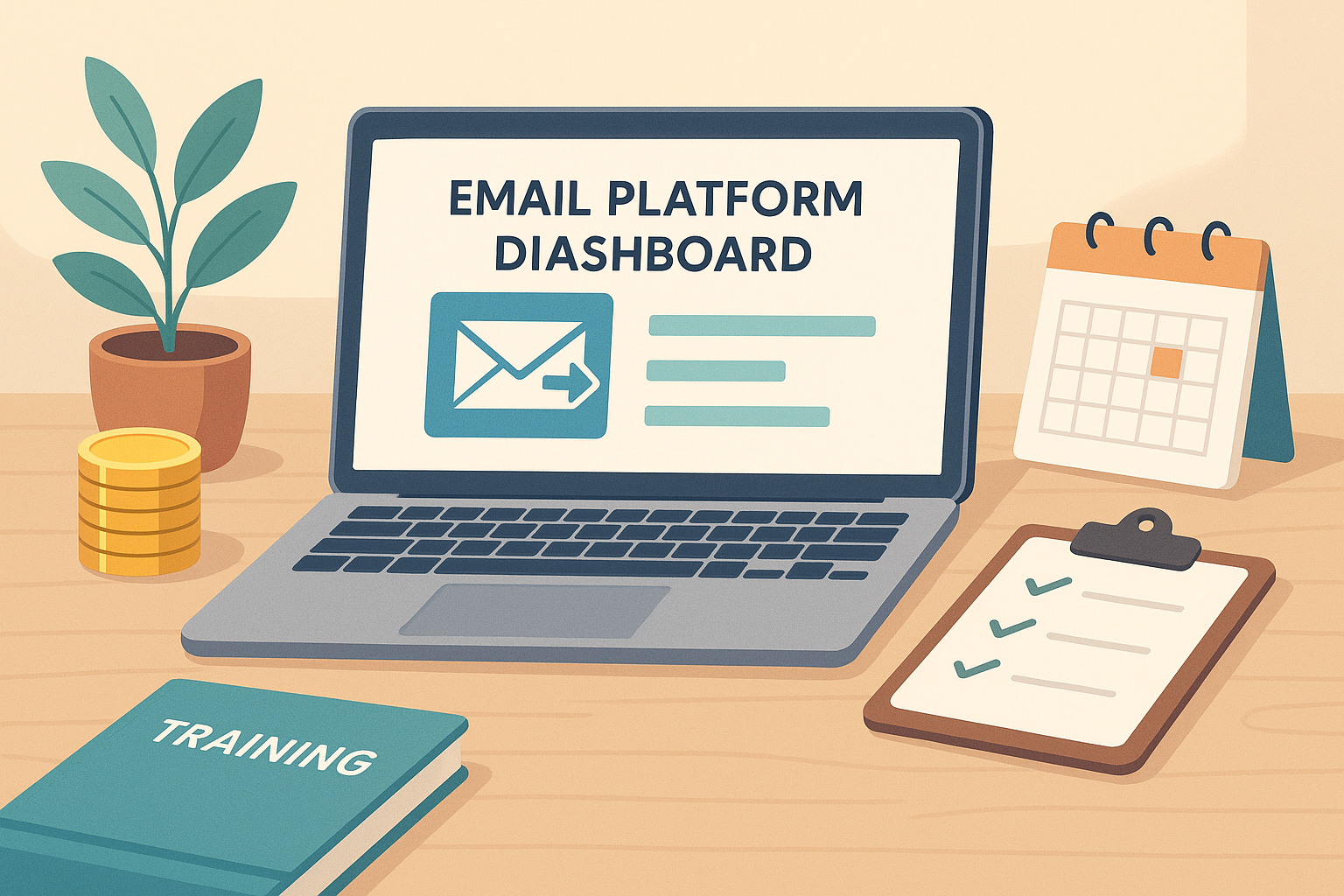Touchpoint analysis is essential for understanding how customers interact with your brand, especially in email marketing. The right tools help track customer journeys, measure campaign effectiveness, and improve engagement. Here are seven tools to consider in 2025:
- Mixpanel: Tracks user actions post-email click with event tracking, cohort analysis, and funnel insights. Pricing starts with a free tier, followed by paid plans from $20/month.
- Kissmetrics: Focuses on person-based analytics, revenue attribution, and behavioral segmentation. Plans start at $299/month.
- Amplitude: Offers behavioral mapping and predictive analytics to refine email campaigns. Free and paid plans available.
- Milkymap: Simplifies customer journey mapping with a user-friendly interface. Pricing starts at $9.50/month.
- Funnel: Consolidates marketing data from multiple sources for custom reporting. Free plans available; enterprise pricing varies.
- Woopra: Provides real-time customer journey tracking and detailed profile updates. Free and paid plans offered.
- LeadsRx: Focuses on multi-touch attribution to link email efforts with revenue. Custom pricing based on business needs.
Quick Comparison:
| Tool | Best For | Starting Price | Key Features |
|---|---|---|---|
| Mixpanel | Small to enterprise | Free/$20/month | Event tracking, cohort analysis, funnel insights |
| Kissmetrics | Mid-sized to enterprise | $299/month | Revenue attribution, behavioral segmentation |
| Amplitude | All business sizes | Free/Custom | Behavioral mapping, predictive analytics |
| Milkymap | Small to large businesses | $9.50/month | Simple journey mapping |
| Funnel | All business sizes | Free/Custom | Data integration, custom reports |
| Woopra | Small to medium businesses | Free/Custom | Real-time tracking, customer profiles |
| LeadsRx | Mid-sized to enterprise | Custom | Multi-touch attribution |
Choose a tool based on your email volume, budget, and integration needs. Test free trials where available to ensure the tool aligns with your goals.
What Tools Help to Monitor and Optimize Sales Touchpoints? | Sales Pro Blueprint News
1. Mixpanel
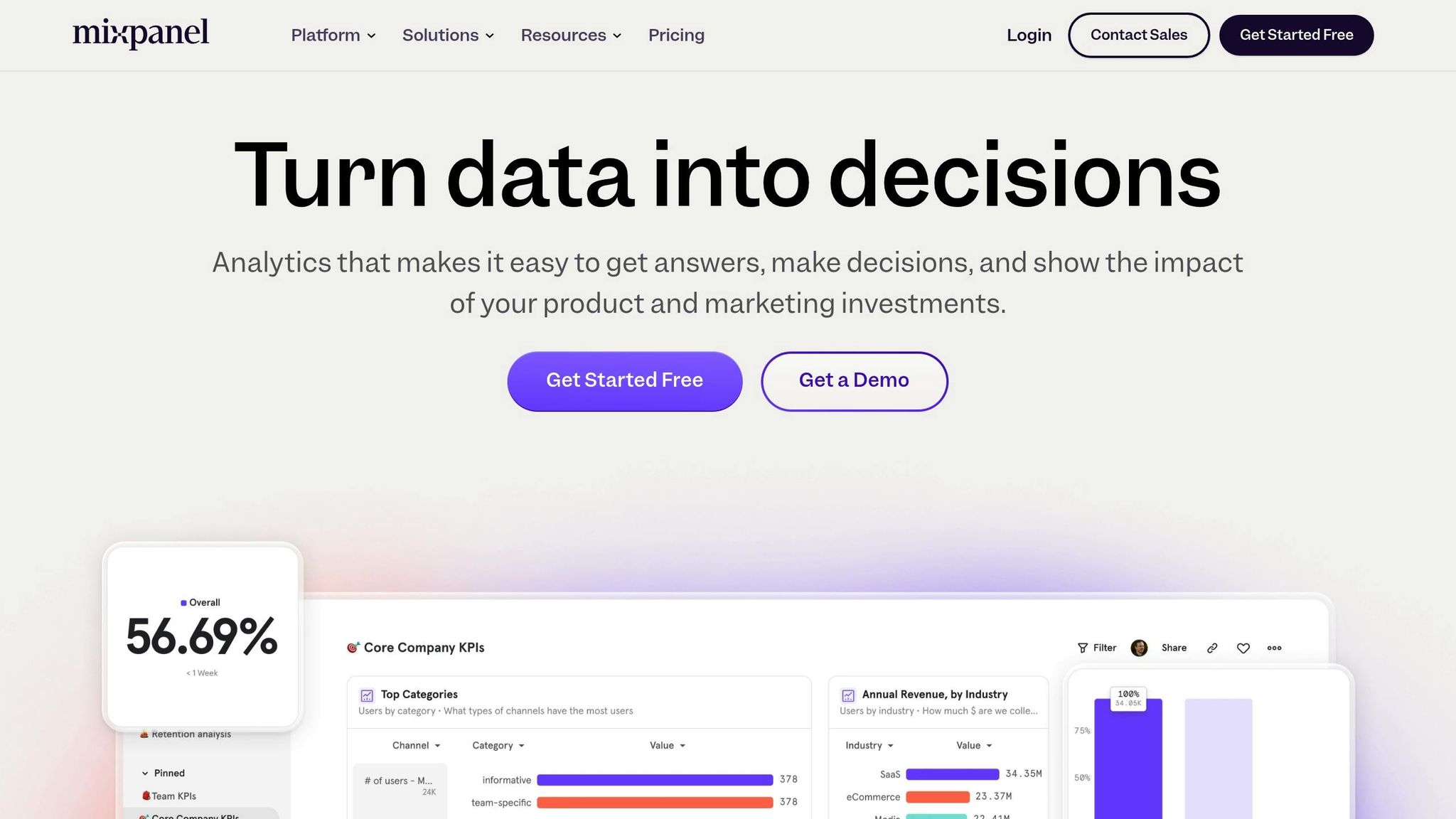
Mixpanel is an analytics platform built around tracking user actions rather than just page views. This event-based approach makes it a powerful tool for understanding how email campaigns influence customer behavior throughout their journey.
Features for Email Marketing and Customer Journey Mapping
Mixpanel’s event tracking lets you monitor what happens after a user clicks a link in your email. Whether it’s viewing a product, adding an item to their cart, signing up for an account, or completing a purchase, you can connect these actions back to specific email campaigns. This gives you a clear picture of how your emails drive engagement and conversions.
The platform also offers cohort analysis, which groups users based on factors like sign-up date or engagement level, allowing for targeted email campaigns. With funnel analysis, you can pinpoint where users drop off between engaging with an email and completing a desired action. Additionally, real-time segmentation enables you to create dynamic audience groups that trigger personalized follow-ups, such as emails for cart abandonment or product browsing.
These features are paired with flexible pricing options, making Mixpanel accessible to businesses of all sizes.
Pricing Options (in USD)
- Free Tier: Includes up to 20 million events per month, basic reporting, and support for up to 5 team members.
- Growth Plan: Starts at $20 per month for up to 100 million events monthly. This plan includes advanced features like unlimited saved reports, data exports, and priority support.
- Enterprise Plan: Pricing is customized for companies handling over 100 million events per month. Costs can range from several hundred to thousands of dollars, depending on specific needs.
Integration with Email Marketing Platforms
Mixpanel integrates seamlessly with major email service providers through API connections and webhooks. Using the JavaScript SDK, you can track what users do on your website after engaging with an email, tagging their actions with campaign data. The platform also supports UTM parameter tracking, making it easy to categorize traffic and measure conversions from various email campaigns. These integrations ensure your email marketing efforts align smoothly with your overall analytics strategy.
Best Fit for Different Business Sizes
- Small Businesses: The free tier is a great starting point, offering essential tracking features without requiring technical expertise.
- Mid-Sized Companies: The Growth plan strikes a balance between cost and functionality, scaling well as email lists expand and customer data becomes more intricate.
- Enterprise Organizations: Mixpanel excels at handling large data volumes while delivering fast performance. Features like custom properties and detailed funnel analysis make it ideal for complex email strategies and customer journey mapping.
Even teams with minimal technical know-how can start with basic setups and gradually unlock more advanced capabilities as their needs grow.
2. Kissmetrics
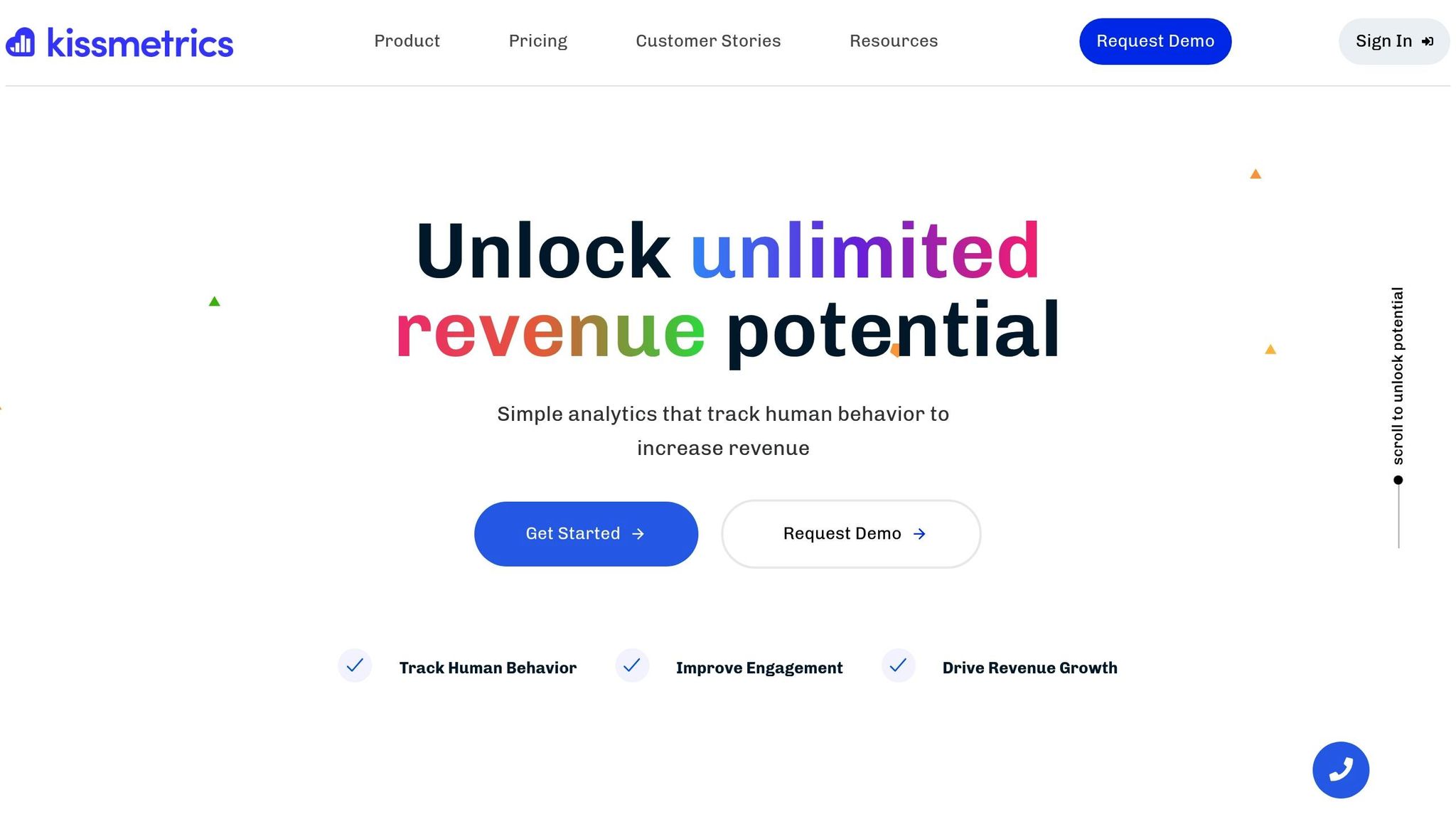
Kissmetrics is a person-based analytics platform designed to track individual customer behavior rather than focusing on anonymous sessions. This makes it a powerful tool for email marketers looking to understand how their campaigns influence each customer's journey.
Features Tailored for Email Marketing and Customer Journeys
Kissmetrics emphasizes person-centric tracking, creating detailed customer profiles that map out how email interactions shape the overall journey. For instance, when someone clicks on a link in an email, Kissmetrics follows their actions, providing a complete picture of their engagement.
One standout feature is revenue attribution, which calculates the revenue generated by each email campaign. It doesn’t just track immediate purchases - it also accounts for conversions that occur days or even weeks later. With multi-touch attribution, you can see how different emails contribute to the conversion process, even if they aren't the final touchpoint.
Another key feature is behavioral segmentation, which allows you to create dynamic email lists based on real customer actions. For example, you can target users who viewed specific product pages, abandoned carts at certain price points, or engaged with past campaigns. These segments update automatically as customer behavior evolves, ensuring your targeting remains relevant.
Kissmetrics also offers advanced A/B testing. Beyond simple subject line comparisons, it measures how email variations impact long-term metrics like customer lifetime value and retention, giving you insights that go far beyond open rates.
These features integrate smoothly with existing email marketing tools, making the platform a valuable addition to your marketing stack.
Pricing Options (in USD)
Kissmetrics uses a subscription-based pricing model that scales with the number of people tracked:
- Silver Plan: $299/month for up to 10,000 people, including core analytics.
- Gold Plan: $499/month for up to 25,000 people, with advanced segmentation and revenue reporting.
- Platinum Plan: Custom pricing starting at approximately $1,500/month, offering support for larger volumes, dedicated assistance, and advanced customization.
All plans come with unlimited events and properties, so you won’t incur extra costs for tracking detailed email campaign data. A 14-day free trial is also available for new users to explore the platform.
Integration with Email Marketing Platforms
Kissmetrics excels in integration, working seamlessly with email marketing platforms through JavaScript codes, server-side APIs, webhooks, and UTM parameters. This setup ensures smooth cross-device tracking and enables automated email triggers.
By adding tracking parameters to email links, Kissmetrics can follow customers throughout their journey on your website. The platform also supports cross-device tracking via email login events, helping you understand how users interact with your emails across desktops, tablets, and smartphones.
Best Fit for Different Business Needs
Kissmetrics is ideal for businesses that require deep insights into long-term customer behavior. It’s particularly well-suited for mid-sized and enterprise companies with established email marketing programs. Its ability to handle complex customer journeys makes it a great choice for businesses with longer sales cycles or those focused on maximizing customer lifetime value.
For e-commerce businesses, the revenue attribution feature is especially valuable, as it highlights how emails influence purchases - whether immediately or after a longer consideration period. SaaS companies can benefit from tracking how campaigns drive trial sign-ups, feature usage, and subscription renewals.
That said, smaller businesses with simpler sales processes may find Kissmetrics too complex and costly for their needs. Companies with straightforward, direct sales funnels might not require the advanced attribution modeling it offers.
B2B companies with lengthy sales cycles often find Kissmetrics indispensable. It provides clarity on how nurture email sequences contribute to conversions, even when those conversions take months to materialize after the initial engagement.
3. Amplitude
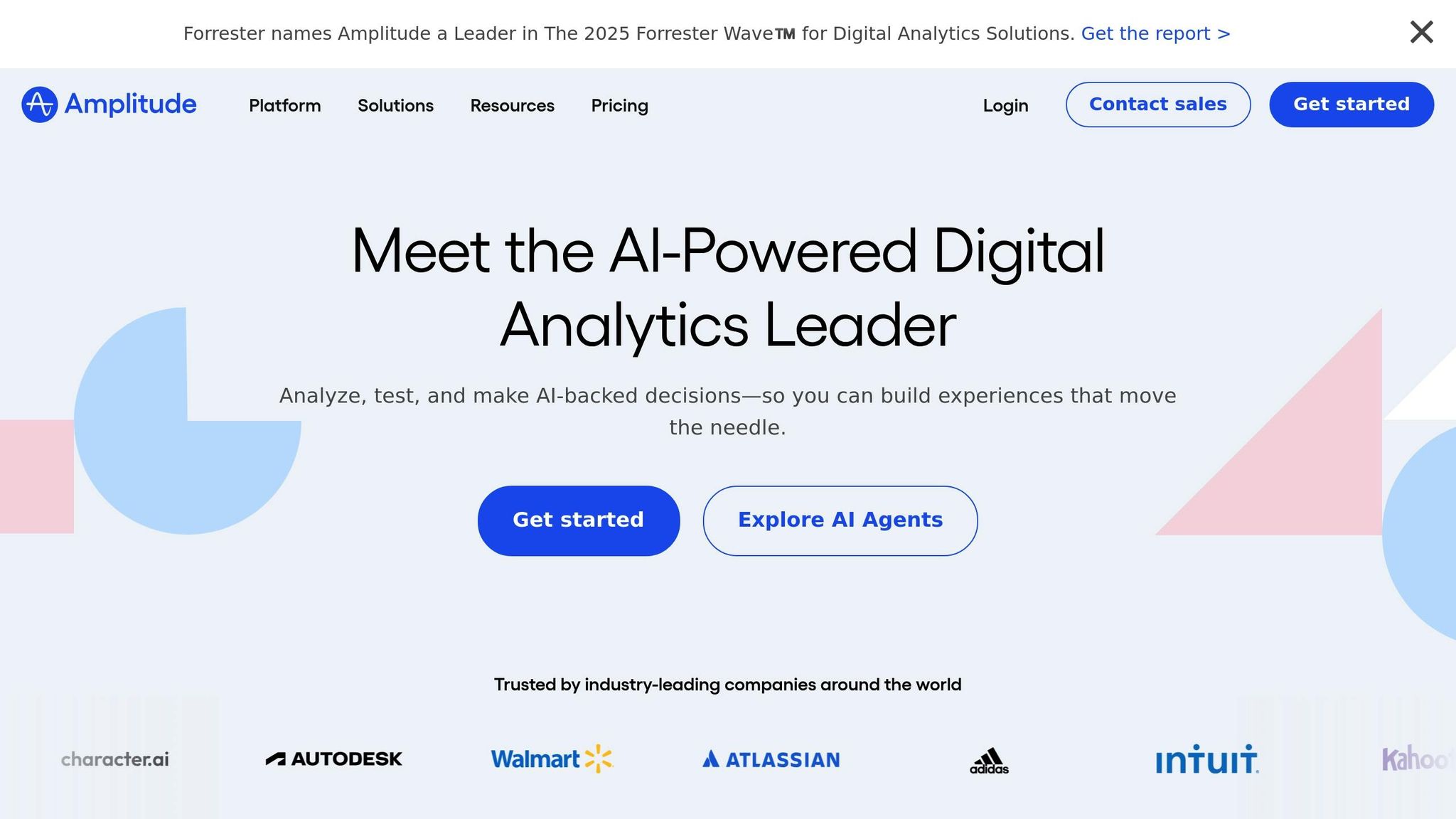
Amplitude stands out for its ability to map customer journeys using its Behavioral Graph. While many tools focus on surface-level metrics, Amplitude dives deeper, offering a detailed look at customer behaviors. This makes it an excellent choice for understanding how email campaigns fit into the bigger picture of the customer experience. By refining insights with behavior mapping, Amplitude takes email campaign analysis to a whole new level.
Features Relevant to Email Marketing and Customer Journey Mapping
Amplitude's Behavioral Graph provides in-depth insights into how email interactions influence customer actions. With predictive analytics powered by machine learning, it identifies high-value customers and predicts their next steps, enabling targeted segmentation. The platform also helps marketers design smarter campaigns by pinpointing key actions and identifying where customers drop off. This insight is invaluable for creating effective nurture flows. Plus, its experimentation platform supports A/B testing, allowing businesses to evaluate the performance of various email strategies.
Pricing Models (in USD)
Amplitude offers a freemium model that caters to businesses of all sizes. The free tier is perfect for smaller teams, while paid plans are tailored to meet specific feature requirements. This flexible approach ensures that startups and large enterprises alike can find a plan that works for them.
Suitability for Different Business Sizes and Needs
Amplitude is a versatile tool that works well for a wide range of businesses - from small startups to large enterprises. It's especially useful for e-commerce and SaaS companies with complex customer journeys. Smaller businesses can start with the free tier to access advanced analytics, while larger organizations can take advantage of scalable, custom solutions. This adaptability makes Amplitude a strong choice for tracking and improving email campaigns.
4. Milkymap
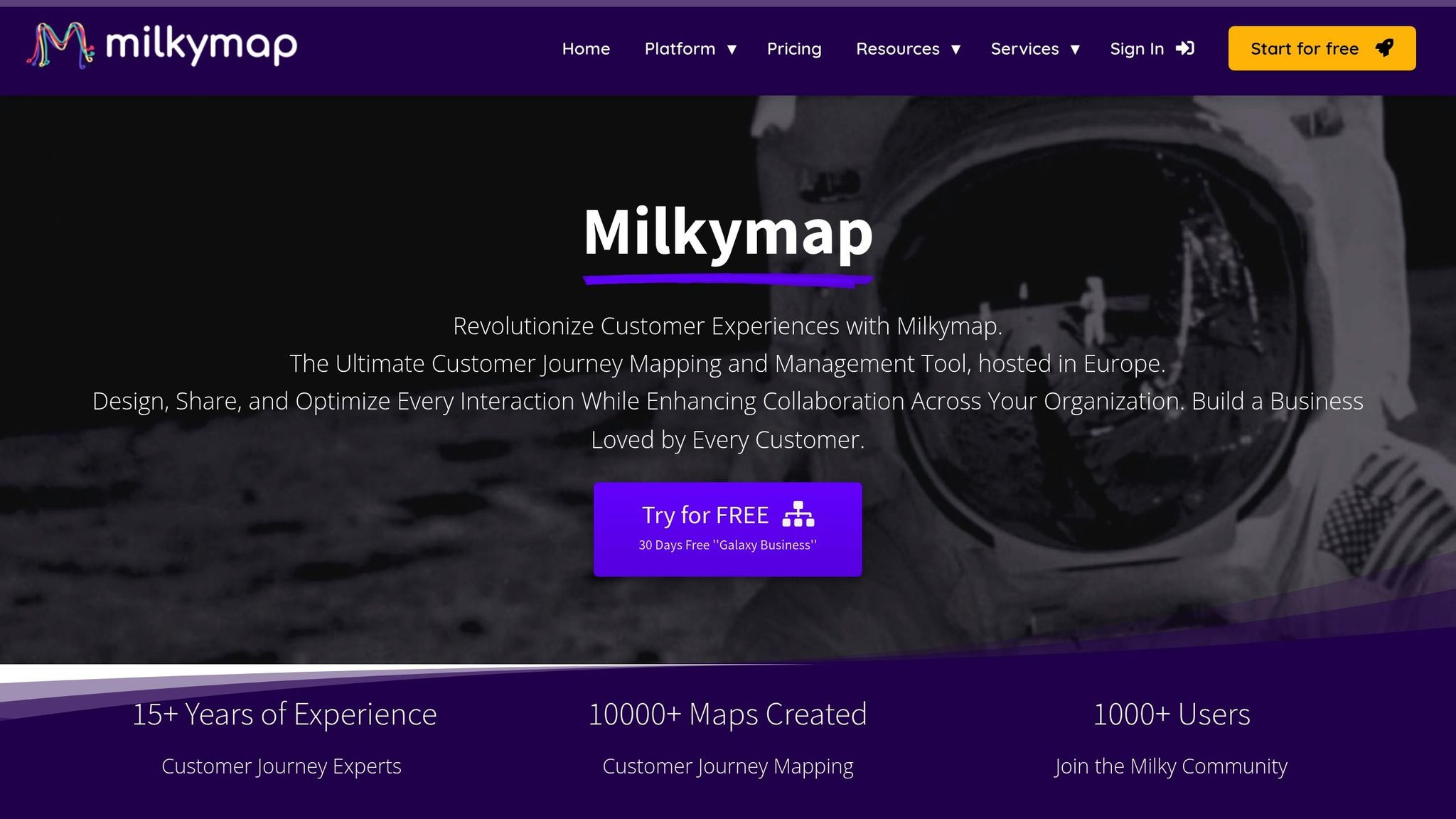
Milkymap makes analyzing customer touchpoints straightforward by presenting insights in a user-friendly way. Instead of bogging users down with complicated tools, it brings customer journey mapping to everyone - whether you’re a marketing pro or a business owner seeking quick, actionable insights.
Features Relevant to Email Marketing and Customer Journey Mapping
Milkymap excels at visualizing customer experiences, helping teams pinpoint opportunities to improve email touchpoints within broader customer journeys. This clarity is a game-changer for optimizing email campaigns, as it highlights the moments that matter most in influencing customer decisions. Its approachable design ensures that both seasoned marketers and beginners can easily understand how email campaigns impact customer behavior. These features make it a valuable tool for teams looking to gain quick, actionable insights from their email strategies.
Pricing Models (in USD)
Milkymap offers pricing options that cater to various budgets. There’s a free version with limited features for those who want to test the waters. Paid plans for individual users start at about $9.50 per month. The platform divides its offerings into two tiers: Satellite plans for individuals and Galaxy plans for teams. For those who prefer annual billing, pricing starts at approximately $118 per year, providing flexibility for different organizational needs.
Suitability for Different Business Sizes and Needs
Milkymap is built to serve everyone - from solo entrepreneurs to large enterprises. Small businesses will appreciate its simple interface and affordable pricing, making it easy to dive into customer journey analysis without a steep learning curve. For medium and large companies, Milkymap offers scalable solutions, advanced collaboration tools, and features tailored for tackling complex customer journeys. Its design fosters teamwork across departments, allowing marketing, sales, customer service, and product development teams to collaborate effectively without requiring extensive training.
5. Funnel
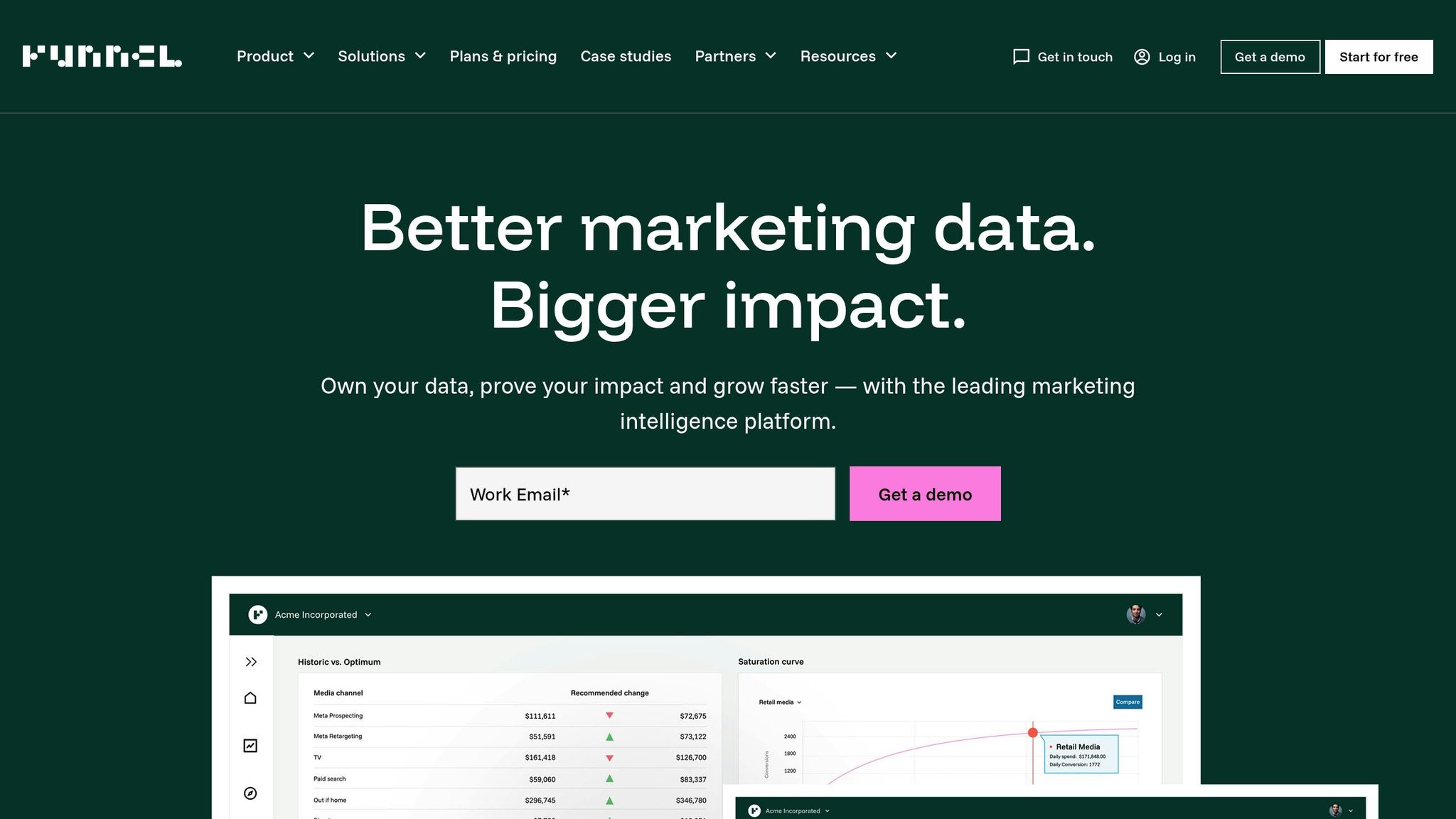
Funnel is a data integration platform designed to consolidate marketing data from various sources into a single, centralized hub. Unlike basic analytics tools, Funnel pulls together information from a wide range of marketing channels, making it easier for businesses to analyze data and create custom reports.
Features Relevant to Email Marketing and Customer Journey Mapping
For email marketers, Funnel provides a powerful way to integrate campaign data with customer interactions across multiple channels. With access to 579 connectors in the Business plan and 590 connectors in the Enterprise plan, businesses can easily pull data from email marketing platforms, social media, paid advertising, and more. Funnel's advanced metrics help assess how email campaigns contribute to customer acquisition and retention, which is crucial for attribution modeling. Additionally, its data hub enables marketing teams to build custom reports that map out the entire customer journey - from the first point of contact to email nurturing sequences and, ultimately, to the final purchase.
Pricing Models (in USD)
Funnel offers flexible pricing to accommodate a wide range of business needs. Its tiered pricing model combines plan functionality with usage-based flexpoints, providing four main tiers to choose from.
- Free and Starter Plans: These plans include 400 flexpoints, support up to 4 connectors, and allow for 1 destination. They require no credit card and have no time limits, making them a great choice for smaller businesses looking to test the platform.
- Business and Enterprise Plans: Pricing for these plans isn’t listed on the website. Instead, businesses must book a demo to receive a custom quote. However, third-party sources suggest that the average annual contract value is around $73,467, with costs ranging from smaller amounts for limited implementations to as much as $1,000,000 annually for large-scale enterprise deployments. Pricing is based on a combination of a base plan and usage-based flexpoints. Funnel Measurement, an advanced analytics add-on available for Business and Enterprise plans, is priced according to monthly digital ad spend and the number of measurement models needed.
Suitability for Different Business Sizes and Needs
Funnel’s tiered structure makes it a versatile option for businesses of all sizes.
- Small Businesses and Startups: The Free and Starter plans are ideal for startups and smaller companies that need basic data connections and reporting capabilities.
- Growing Businesses and Agencies: The Business plan is a popular choice for midsized companies and digital marketing agencies, offering advanced tools for customer journey analysis.
- Large Enterprises: The Enterprise plan is designed for large organizations with complex needs. It includes features like Single Sign-On, advanced roles and permissions, audit logs, and EU Data Center availability. This plan also supports enterprise-level SLAs and is well-suited for companies with multiple brands or regional operations.
With its scalable options and robust feature set, Funnel caters to a wide range of businesses, from startups to large enterprises, making it a valuable tool for comprehensive marketing data analysis.
sbb-itb-6e7333f
6. Woopra
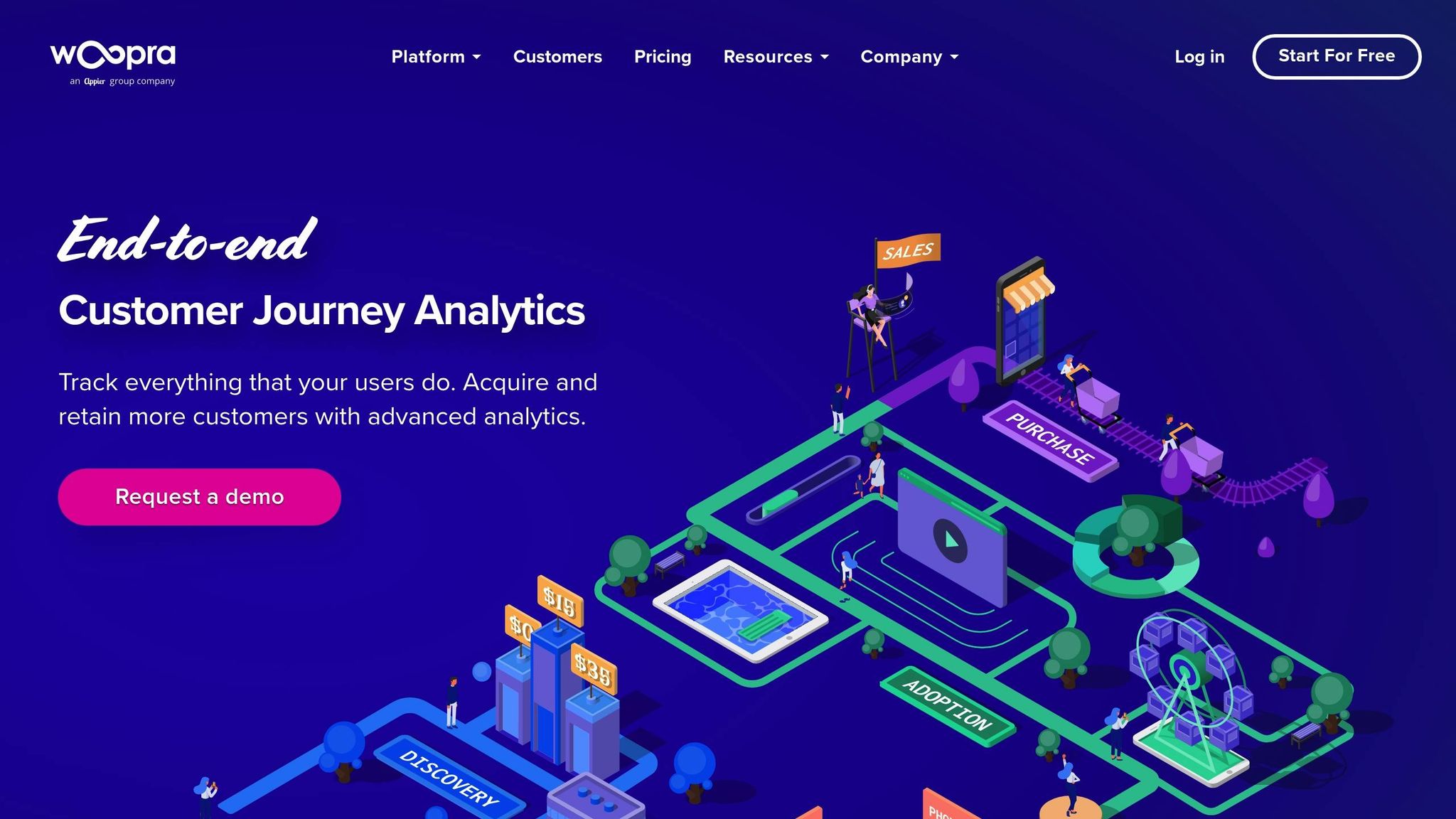
Woopra is a customer analytics platform designed to track individual journeys across multiple touchpoints, updating detailed customer profiles in real time. This makes it a powerful tool for integrating insights from email campaigns into the broader customer experience.
What sets Woopra apart is its focus on individual-level tracking. It shows how specific customers interact with your brand across various channels. For email marketers, this means going beyond aggregate campaign data to understand the full picture of customer journeys.
Features Relevant to Email Marketing and Customer Journey Mapping
Woopra builds unified customer profiles by combining email engagement data with website activity, purchase history, and even support interactions. It tracks key email metrics like opens, clicks, and conversions, linking them to follow-up actions such as website visits or purchases. The journey mapping feature allows you to visualize how customers move through different stages of their lifecycle, helping identify which email content drives the most impactful actions.
Real-time notifications are another standout feature. Teams can get alerts when high-value customers engage with emails or abandon carts, enabling quick follow-ups with personalized messages or automated workflows.
The platform’s cohort analysis groups customers by their join date, providing insights into how engagement and purchasing behaviors evolve over time. This is especially useful for evaluating the long-term value of different email acquisition strategies.
Pricing Models (in USD)
Woopra offers a tiered pricing structure to suit various business needs.
- Free Plan: Includes basic tracking features, perfect for smaller businesses testing out the platform.
- Paid Plans: Unlock advanced capabilities like enhanced segmentation, detailed journey mapping, custom reporting, and priority support - ideal for growing businesses.
- Enterprise Pricing: Tailored for organizations with high tracking volumes or complex requirements, offering advanced security and custom integrations.
Integration Capabilities with Email Marketing Platforms
Woopra integrates seamlessly with major email marketing platforms through native connections and APIs. These integrations automatically sync campaign data and customer engagement metrics, ensuring email interaction data is reflected in customer profiles.
The platform’s webhook system supports real-time updates between Woopra and email tools, while custom event tracking allows businesses to define specific email-related actions to monitor. With bidirectional data flow, insights from Woopra can automatically update email subscriber segments, enhancing segmentation and re-engagement strategies.
Suitability for Different Business Sizes and Needs
Woopra’s intuitive interface makes it a great choice for small to medium-sized businesses looking to refine email-driven customer journeys. It’s particularly useful for teams without dedicated analytics resources. For growing companies, the platform’s scalability and advanced segmentation tools provide room to expand. Meanwhile, enterprise organizations can benefit from custom integrations and in-depth analytics.
E-commerce businesses, in particular, can leverage Woopra to track customer journeys from email clicks to purchases. This capability helps measure how email campaigns directly contribute to sales, making it easier to fine-tune strategies for maximum impact.
7. LeadsRx
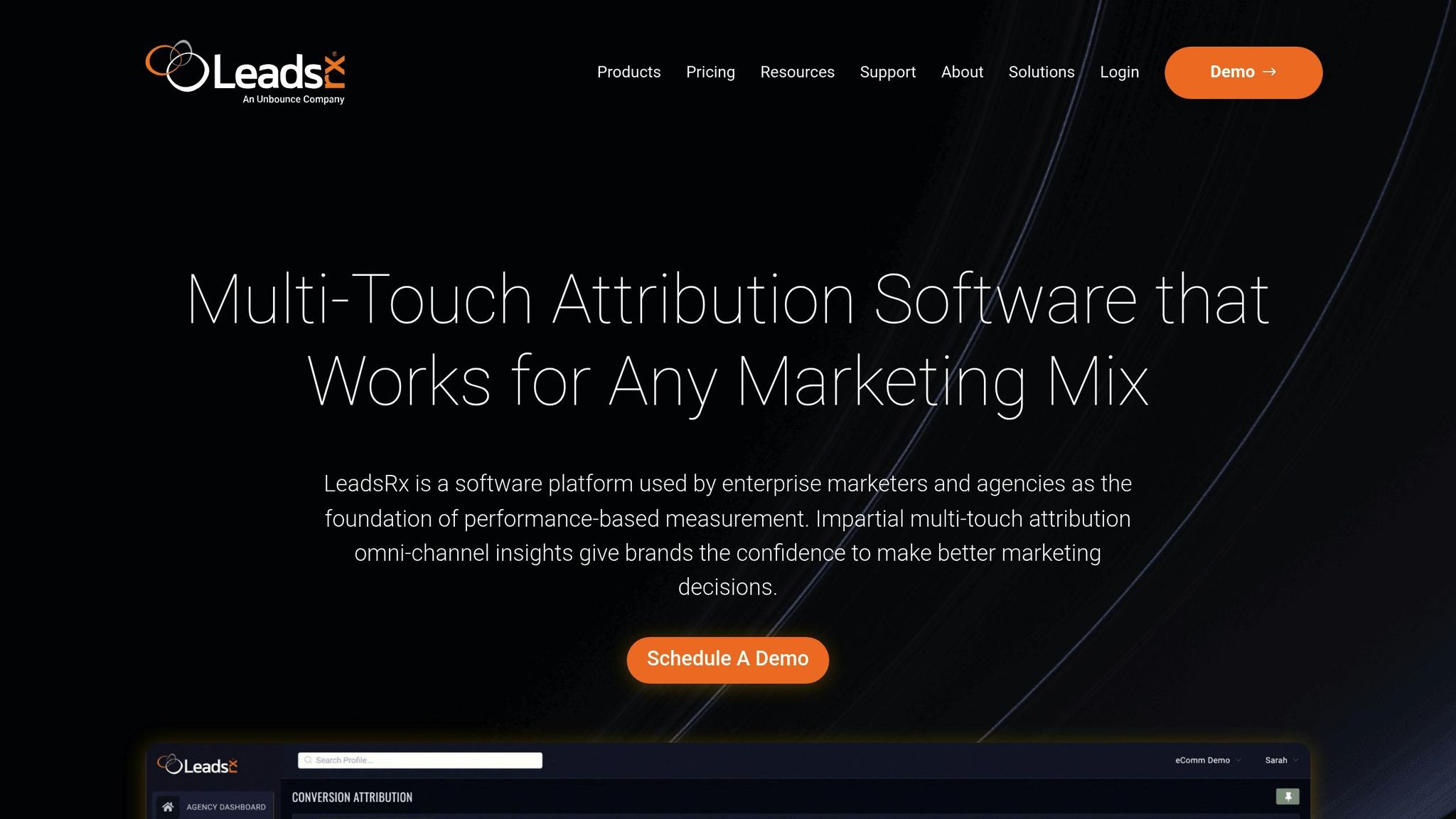
LeadsRx is a marketing attribution platform designed to evaluate the impact of every customer interaction. Unlike tools that focus only on last-click attribution, LeadsRx uses advanced modeling to show how each touchpoint contributes to conversions throughout the entire customer journey.
One of its standout features is how effectively it connects email marketing efforts to revenue. By tracking customers from their first email interaction through multiple touchpoints, it provides a detailed look at how email campaigns work alongside other marketing strategies to drive sales and conversions.
Features Relevant to Email Marketing and Customer Journey Mapping
LeadsRx employs multi-touch attribution to distribute credit across all interactions, offering a clear view of the customer journey. It highlights key email touchpoints with visualized paths and uses cross-device tracking - leveraging both deterministic and probabilistic matching - for accurate customer profiling. Additionally, its revenue attribution reports differentiate between direct revenue from emails and assisted conversions, offering deeper insights into campaign performance.
Pricing Models (in USD)
LeadsRx follows a custom pricing approach tailored to each business. Pricing depends on factors like monthly marketing spend and tracking volume. For specific details, businesses need to contact LeadsRx directly.
Integration Capabilities with Email Marketing Platforms
LeadsRx integrates easily with major email marketing platforms through native integrations and API connections. Real-time data syncing ensures campaign metrics are updated immediately. The platform also supports UTM parameter tracking and custom email tracking codes to measure the impact of specific campaigns. Webhook integrations allow for bidirectional data flow, while custom event tracking captures actions like email forwards or social shares, giving a deeper understanding of email engagement.
Suitability for Different Business Sizes and Needs
LeadsRx is ideal for mid-sized to large enterprises with significant marketing budgets and complex customer journeys. E-commerce businesses can use it to see how email campaigns complement other marketing efforts, while B2B companies with longer sales cycles gain insights into how emails nurture leads and drive conversions. For businesses looking to measure email marketing ROI and optimize their marketing spend across channels, LeadsRx offers a robust solution.
Learn more about touchpoint analysis at Email Service Business Directory.
Tool Comparison Chart
Selecting the best touchpoint analysis tool for your email marketing strategy depends on your goals, budget, and technical needs. For the most up-to-date details, it's always a good idea to visit the vendor's official website.
Here’s a quick look at the seven tools discussed in this guide:
| Tool | Highlights |
|---|---|
| Mixpanel | Visit the vendor's website |
| Kissmetrics | Visit the vendor's website |
| Amplitude | Visit the vendor's website |
| Milkymap | Visit the vendor's website |
| Funnel | Known for seamless integrations |
| Woopra | Visit the vendor's website |
| LeadsRx | Visit the vendor's website |
Keep in mind that integration capabilities and pricing structures differ between tools. Be sure to align these features with your email marketing platform and overall strategy.
This chart provides a snapshot to complement the detailed analysis of each tool found earlier in this guide.
For more in-depth insights into email marketing tools and strategies, explore the Email Service Business Directory.
Conclusion
Choosing the right tool for your business in 2025 can make or break your email marketing efforts. The seven tools highlighted in this guide each offer distinct advantages, but the key is selecting one that aligns with your business size, email volume, and integration requirements.
For small businesses working with tight budgets, options like Woopra or Kissmetrics strike a great balance between functionality and affordability. Mid-sized companies managing thousands of daily email interactions might find Mixpanel’s detailed event tracking or Amplitude’s intuitive interface particularly useful. Meanwhile, enterprise-level organizations with intricate omnichannel strategies often require the advanced attribution modeling capabilities of LeadsRx or other high-level solutions tailored for large-scale operations.
Make sure the tool you choose integrates smoothly with your existing email platform, CRM, and other essential technologies to prevent data silos from disrupting your workflow.
Take advantage of free trials to test for factors like data accuracy, reporting speed, and overall usability.
If you're looking for a deeper dive into email marketing platforms and service providers that pair well with these tools, check out the Email Service Business Directory for detailed comparisons and expert insights.
FAQs
How can I choose the best touchpoint analysis tool for my business?
Choosing the right tool for touchpoint analysis hinges on your business's size, objectives, and budget. For small businesses, it’s smart to focus on tools that are easy to use and affordable. Look for options that cover the basics, like tracking key customer interactions and identifying ways to boost satisfaction.
On the other hand, larger organizations often need more advanced platforms. These might include features like in-depth customer journey mapping, multi-channel tracking, and powerful analytics to handle more complex marketing efforts.
When evaluating tools, think about your budget, the technical skills of your team, and the specific touchpoints you want to monitor. Make sure the tool matches your goals and has the flexibility to grow with your business as your needs expand.
How do Mixpanel and Kissmetrics compare for email marketing?
Mixpanel vs. Kissmetrics: Which One Fits Your Email Marketing Needs?
When it comes to email marketing, both Mixpanel and Kissmetrics bring their own strengths to the table, catering to different business needs.
Kissmetrics shines with its simple, intuitive interface and impressive ability to track customer journeys in detail. If your focus is on creating targeted campaigns, this tool makes it easier by linking events to specific users, helping you understand customer behavior without much hassle. It’s a solid pick for businesses prioritizing straightforward tracking and campaign management.
On the flip side, Mixpanel is a powerhouse for advanced analytics, particularly for mobile platforms. Its strengths lie in event tracking and user segmentation, offering businesses the tools to dive deep into data for actionable insights. While it might take some time to get the hang of, its capabilities are perfect for those who need a more analytical edge.
In short, if you’re after simplicity and clear campaign insights, Kissmetrics is a great match. But if you want to dig deeper into data and segmentation, Mixpanel is the way to go.
What steps can I take to ensure a new touchpoint analysis tool integrates seamlessly with my email marketing platform?
To make the integration process as smooth as possible, start by verifying that the tool is compatible with your current email marketing platform and other systems, such as CRMs or e-commerce platforms. Prioritize tools that offer strong API support and pre-built integrations to simplify the setup process.
Before committing to a tool, take the time to outline your goals and technical needs. This ensures the tool fits seamlessly into your existing workflows. After implementation, keep your data formats consistent and regularly check for synchronization issues to prevent any disruptions. Following these steps can streamline your integration process and improve the efficiency of your email marketing efforts.


